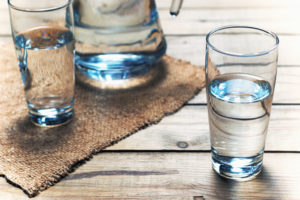 Recent weather and above-average, record-breaking temperatures have me wondering if I drink enough liquid, especially water. The human adult body is approximately 55 to 60 percent water. Staying hydrated is essential to our health and helping our bodies function optimally.
Recent weather and above-average, record-breaking temperatures have me wondering if I drink enough liquid, especially water. The human adult body is approximately 55 to 60 percent water. Staying hydrated is essential to our health and helping our bodies function optimally.
How does water function in our bodies?
- Regulates body temperature
- Lubricates joints
- Flushes body waste
- Nourishes brain and spinal cord
- Helps deliver oxygen
Water is vital to our survival. Decreased hydration can result in drops in mood, skin moisture, blood pressure, and energy level. It can also contribute to symptoms of cognitive impairment.
How much fluid should you consume each day?
Past guidelines have advised eight cups per day, but new recommendations suggest higher intake. Our individual needs differ based on gender, age, where we live, activity levels, and overall health. The National Academies of Sciences, Engineering, and Medicine determined that adequate daily fluid intake is:
- About 15.5 cups (3.7 liters) of fluids for men
- About 11.5 cups (2.7 liters) of fluids a day for women
How do you make certain that you are consuming enough?
There are various healthy habits you can adopt to be certain that you drink enough liquids. Here are some simple, effective ideas that I’ve found helpful:
- Buy a water bottle that is easy to clean and comfortable to tote. This way you will always have water or some other hydrating beverage at the ready. Put rubber bands around your water bottle to track consumption. Remove one each time you finish the contents. Example: my water bottle is 32 ounces = 4 cups. I should be drinking at least 11.5 cups of water per day, so I put three rubber bands on my bottle, removing one each time I finish a bottle, before refilling.
- Keep a pitcher of chilled water in your refrigerator. Add slices of strawberry, cucumber, citrus fruits, or sprigs of a favorite herb to add flavor without calories. If the water tastes good, you are more likely to drink it. (I keep mine on the counter as I prefer my water less chilly.)
- Make sure you have plenty of fruits and vegetables handy, as most are 90 percent water. Apples, cucumbers, strawberries, celery, spinach, and melon (especially watermelon) are popular choices. They also add nutrients and fiber and are a great excuse to visit your local farmers’ market!
- Take sips throughout the day. Don’t consume large quantities all at once.
- Drink a glass of water with each meal and between each meal (and yes, coffee and tea consumption count).
- Drink water before, during, and after physical activity.
What are the symptoms of dehydration in adults?
- Extreme thirst
- Dry, cool skin
- Headache
- Rapid heartbeat
- Dizziness and/or fainting
- Confusion
- Infrequent urination
- Dark-colored urine
- Fatigue
How do you know you are hydrated?
- You don’t feel thirsty often.
- Your urine is colorless or pale yellow. If it is a deeper yellow or amber, then you know you need to increase your level of hydration.
Hydration tips for caregivers
According to the Mayo Clinic, “Thirst isn’t always a reliable early indicator of the body’s need for water. Many people, particularly older adults, don’t feel thirsty until they’re already dehydrated. That’s why it’s important to increase water intake during hot weather or when you’re ill.”
If you are caring for an older person, you know that hydration can be a challenge. It is important to remind older people about drinking water, as signals for thirst in the brain change over time, especially if someone is living with dementia. Proper hydration can also help keep urinary tract infections (UTIs) at bay and counter the dehydrating effects of some medications.
Be mindful that an individual concerned about incontinence or bathroom access when in public may use this as an excuse to not drink adequate amounts of fluid (though they may not articulate it in that way). Encourage regular sips of a beverage. Be aware of how often bathroom breaks occur.
If outings and potential accidents are a concern, consider using a public bathroom finder app such as Flush. When you have a planned outing, call ahead to find out about bathroom access and locations, and subtly scout the locations of facilities when you arrive. If an individual needs assistance with toileting, have a change of clothing and extra incontinence products (if they are regularly used by the individual) handy as back-up.
No single approach works for everyone. Experiment and explore your options. With a little planning and new habits, you will soon be hydrating appropriately and experiencing the benefits.
About the Author: Contributor Juliet Powell leads Creative Engagement at Aging Wisdom, an Aging Life Care practice based in Seattle. Juliet is a certified home care aide who has worked in the field of aging since 2012. She facilitates Professional Boundaries Training and is involved with hiring, training, and supervising Aging Wisdom creative engagement specialists.